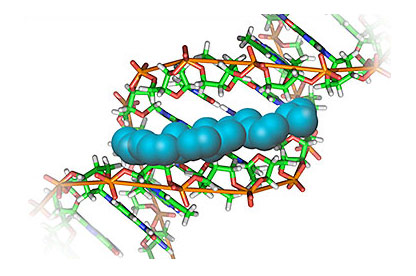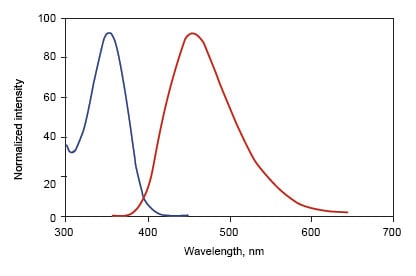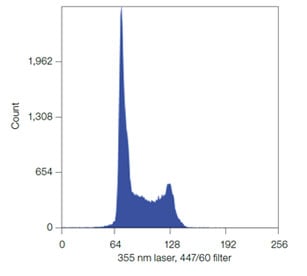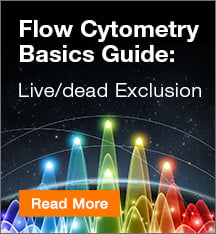Hoechst 33342
Bio-Rad's PureBlu™ Hoechst 33342 Dye is ideal for routine nuclear staining in fluorescence microscopy, cell imaging applications and cell cycle analysis in flow cytometry. It is available as a ready-to-reconstitute, highly pure powder form, with only one dilution step required to obtain a ready-to-use solution.
Hoechst 33342 Binding
Hoechst 33342 is a well-characterized blue-emitting fluorescent compound widely utilized for nuclear staining. Hoechst 33342 permeates cell membranes and binds to the minor groove of A/T-rich dsDNA sequences, thus preferentially staining nuclei (Figure 1).

Fig.1. Hoechst 33342 (in blue) binding dsDNA.
Hoechst 33342 Excitation / Emission Spectra
When bound to dsDNA, Hoechst 33342 has a maximum excitation wavelength in the ultraviolet range (350 nm), and the dye can be optimally detected in the blue channel with an emission maximum of 461 nm (Figure 2). The characteristic wide Stokes shift between excitation and emission wavelengths for Hoechst 33342, make this dye an optimal choice when good spectral separation is desired to reduce fluorescence interference, for example, in chromatin counterstaining for immunofluorescence microscopy.

Fig.2. Hoechst 33342 excitation and emission spectra. Maximal excitation at 350 nm (blue) and maximal emission at 461 nm (red).
PureBlu Hoechst 33342 Nuclear Staining Dye is compatible with fixed and unfixed cells. Compared to DAPI, it exhibits greater permeability toward intact cell membranes and is preferred when conducting experiments with unfixed live samples.

Fig.3. PureBlu Hoechst 33342 use for cell cycle analysis on the ZE5 Cell Analyzer.
GO/G1 and G2/M peaks are separated by the S phase. Jurkat cells were fixed in cold 70% ethanol for 2 hours and then washed. The cells were then stained with Hoechst 33342 in buffer containing 0.1% Triton X-100 for 30 min prior to analysis. Samples were gated to remove doublets.
Preferred choice for unfixed samples
Use PureBlu Hoechst 33342 Nuclear Staining Dye with fixed and unfixed cells. It has increased permeability toward intact cell membranes when compared to DAPI and therefore is preferred when using unfixed samples.
Related documentation
- PureBlu™ Hoechst 33342 Nuclear Staining Dye 取扱説明書
- PureBlu™ Hoechst 33342 Nuclear Staining Dye Product Insert (inc. protocol)
To determine cell viability we also offer the non membrane permeable DNA-binding cell staining dyes Readidrop 7-AAD and Readidrop propidium iodide, in ready-to-use formulations and fixable VivaFix™ Cell Viability Assays in a range of excitation and emission spectra to enable easy incorporation into multi-color Flow Cytometry panels.





